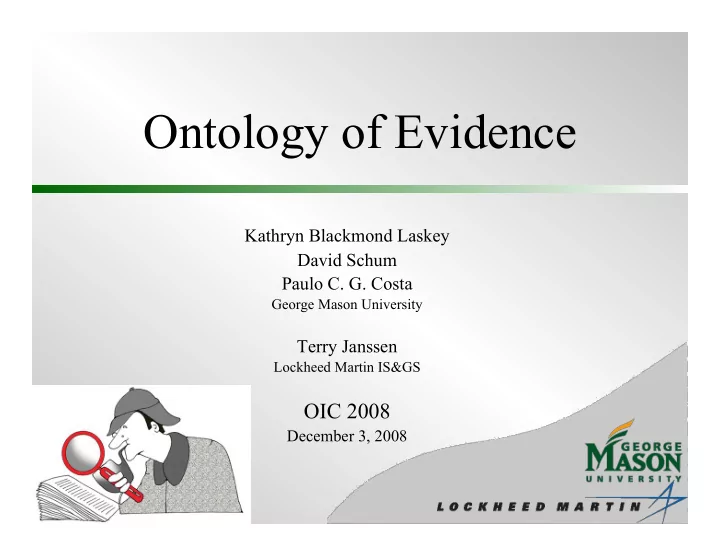

Ontology of Evidence Kathryn Blackmond Laskey David Schum Paulo C. G. Costa George Mason University Terry Janssen Lockheed Martin IS&GS OIC 2008 December 3, 2008
In the olden days… We built stovepipes • Stand-alone systems • Used by a single organization for a single purpose • Specialized formats for inputs and outputs • Idiosyncratic database schema • Key assumptions documented on paper or not at all • Labor-intensive manual transformation of outputs for use by another stovepipe 2
A Whole New World… The Net Centric World-to-Be: Autonomous software agents interoperate seamlessly Collective behavior emerges to address information needs Each agent has timely access to mission-critical information Agents are not overloaded with unnecessary information Information is properly synchronized and up-to-date Multi-level security permits needed access while preventing non-authorized use Semantic technology is an essential enabler! 3 http://www.emporia.edu/earthsci/student/graves1/project.html
What Information to Exchange? Intelligence analysts draw conclusions from evidence Evidential reasoning must account for uncertainties: • Noise in sensors • Incorrect, incomplete, deceptive human intelligence • Lack of understanding of cause and effect mechanisms in the world We must exchange more than reports & conclusions: • Sources • Context • Pedigree 4 • Credibility
Some Key Attributes of Evidence Person X is Relevance in Karachi • How does the evidence bear on H? Person X’s Basic car is in - Direct Pattern Karachi - Circumstantial Informant Y reports that - Indirect (ancillary) Person X’s car is in Karachi Credibility Weight • How trustworthy or • How strong is the relationship between believable is the evidence? - Tangible the evidence and H? - Testimonial - Authoritative records 5 (Schum, 1994)
Some Entity Types Sources and their characteristics • Sensors • Human agents • Forensic artifacts Environmental and contextual factors Hypothesis sets • Binary • Categorical • Ordinal • Numeric (discrete, continuous) Reports 6
Some Attributes of Credibility Tangible evidence (e.g., image) • Authenticity of report • Sensitivity of sensor • Specificity of sensor • Reliability of sensor Testimonial evidence (e.g., informant report) • Veracity of source • Objectivity of source • Competence of source with regard to reported event 7
Probability and Ontology Probability is a well-established representation for evidential weight • Represent statistical regularities in domain • Combine statistical information with expert knowledge • Draw powerful inferences under uncertainty Probabilistic semantics supports interoperability • More than just numbers! • Much of the value of probabilistic representation is structural 8
Example: Independent Reports A priori First report Second report CurrentLocation( x ) isa PhysicalLocation Third report ReportedLocation( r ) isa LocationReport Subject( r ) = x 9
Credibility and Evidential Force 10
Example: Common Source 11
PR-OWL A Language for Expressing PR-OWL: Probabilistic Ontologies Extends W3C recommended OWL ontology language Based on expressive probabilistic logic Represents probabilistic knowledge in XML-compliant format. Open-source, freely available solution for representing knowledge and associated uncertainty in a principled manner. Reasoner under development at University of Brasilia • Beta version released July, 2008 on SourceForge (Costa, 2005) 12 PR-OWL classes
Summary Evidential reasoning is fundamental to intelligence analysis Realizing net-centric vision requires sharing credibility and pedigree as well as reports and conclusions Capturing semantics of evidence is necessary Probabilistic ontology can represent both structural and numerical aspects of evidential reasoning 13
Questions? 14
Recommend
More recommend